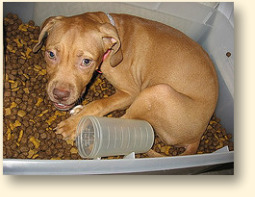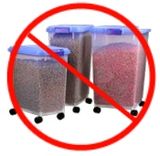Pet Food Storage
Recommendations and Tips
We've compiled these important pet food storage tips, and recommendations for the best dog food containers to help you ensure your pooch is eating the freshest and healthiest dog food possible.
 |
Hopefully, you've reviewed our dog food ratings and comparison chart, and are now feeding the best natural dog food to your furry pal.
However! Unless you adopt careful pet food storage habits, even that premium dog food could be causing your pet more harm than good.
For the full picture, please also take a minute to read these in-depth and eye-opening pet food storage articles:
- Dog
Food Storage and Shelf Life
What you need to know before even purchasing that bag of premium dog food. - Pet
Food Containers and Oxidization
What starts to happen to dog food as soon as it's exposed to air, and why proper pet food storage is so critical.
Pet Food StorageRecommendations |
|
Dry Pet Food Storage |
|
| DO'S | DON'TS |
|
Feed opened dry dog food for a maximum of six weeks only. "Use By" (or "Best Used By", etc.) dates apply to sealed bags only. After six weeks, the nutritional value of the dog food is substantially lower than when the bag is first opened. To help you keep track, date the bag of dog food with a marker when you open it, and throw out any kibble remaining after six weeks. |
Never buy dog food with harmful artificial preservatives. Dog food with artificial preservatives generally has a longer shelf life than kibble. However, the risks of these harmful chemicals far outweigh any benefits. |
| Always store dog food in its
original
bag. Place the whole bag into airtight pet food storage
containers.
1) The packaging helps protect the kibble from oxygen and humidity. The premium dog food companies also use better quality packaging, including the use of oxygen barrier bags made of petroleum products. This packaging, in particular, is very effective at keeping out oxygen and moisture. After feeding your puppy, squeeze as much air out of the bag as possible, re-seal it, or fold the top over very tightly and apply a clip. 2) The original bag of dog food contains the barcode, batch code, and expiration date. This identifies the particular batch of food you're feeding your pooch. It is very important information to have in the event of a dog food recall, or if you suspect any problems with the food. |
Do not pour kibble directly into
dog food
containers.
This is a very common, but dangerous dog food storage practice! 1) Residual fats and oils that settle at the bottom and sides of the pet food storage bin can become rancid and contaminate fresh new food. 2) Harmful chemicals from plastic pet food containers can seep into the dog food. 3) This increases the risk of storage mites, mold growth, and bacterial contamination, leading to food poisoning, vomiting and/or bad diarrhea. |
*** Recommended ***AIRTIGHT Pet Food Storage Containers |
|
|
See here for a wide selection of: Glass and metal are both extremely
effective
oxygen and humidity barriers. Attractive too! This gorgeous Extra Large Brushed Stainless Steel Pet Food Storage Can This 69 Quart Plastic Airtight Pet Food Container Airtight SOFT Pet Food Storage Containers |
|
| Store dry kibble in a cool, dry
place, such
as a pantry.
Ideally, dry dog food should be stored at a temperature of less than 70 degrees F, and at less than 15% humidity. Avoid storing dry dog food in fluctuating temperatures as this causes condensation, i.e. moisture!
|
Never store open bags of dry dog
food for
lengthy periods in warm, humid areas, or in sunlight.
Heat and moisture promote the growth of mold and cause fats to go rancid. If the bag of dog food does come into contact with water - for instance, a wet kitchen floor or leaking basement - Discard it! |
| Be cautious when storing dry dog
food in the
freezer.
The freezer can add moisture to the food. Kitchen vacuum sealers are ideal for preventing the kibble from moisture exposure. If you don't have one, you can store small batches of kibble in zip lock bags or small airtight food containers. Take out only enough to last your dog a few days. |
Do not feed pet food that has
discolored or
does not smell right.
Return it to the store you purchased it from, and/or contact the dog food manufacturer providing details of the bar and batch code, and expiration date. |
| Wash
all pet food containers frequently.
Old rancid kibble can contaminate fresh, new kibble. Use a gentle detergent and very hot water. Ensure you dry all dog food storage bins completely before refilling. |
Never ever purchase kibble or dog
treats
from open food bins at bulk food stores!
This is really playing with fire! Not only do you not know what you're really buying, but there's the increased risk of mold and bacterial contamination, diminished nutrients, bugs, etc, etc. Don't do it! |
| Preferably, choose glass or
stainless steel dog food
bins over plastic containers.
Glass and metal pet food bins are very effective oxygen and humidity barriers. Plastic pet food storage containers are not as effective as, over time, oxygen seeps through the polyethylene walls of the storage bins. Small metal or glass dog food containers are perfect for storing smaller bags of dog food and dog treats.Many of the premium dog food companies use quality zip lock bags for their dog treats. Keep the treats in the bag, and put the original bag into the jar. Always use airtight pet food containers and apply the same storage principles to dog treats as kibble. |
Avoid buying unopened dog food in
bulk
unless you absolutely have to.
If you have to buy bulk dog food (e.g. For cost savings or lack of local access to premium dog food brands), be sure to store the bags in airtight pet food storage containers. Unopened dry dog food can last from four months to three years (depending on the pet food manufacturer, the brand, the formula, and whether artificial or natural preservatives are used). The average shelf life for unopened dog food containing natural preservatives is approximately one year. If the bag has never been opened and is in good condition, it acts as a protective barrier. Not enough oxygen and moisture can penetrate the closed bag in a year, to cause significant oxidation or microbial growth concerns. |
| Place small amounts of kibble at
a time in
pet food dispensers.
Dog food dispensers can be very convenient. However, if not used properly they can also pose serious health risks for your dog or puppy. Don't let kibble sit in the dog food dispenser for lengthy periods, and avoid contamination by not adding fresh kibble on top of older kibble. Wash dispensers frequently in very hot water! |
Avoid exposure to storage mites
and other
pests.
Dogs with allergies are frequently allergic to storage mites. Storage mites commonly thrive in the grains in dry dog foods. One of the most common storage mites, "Tyrophagus Putrescentiae", a mold mite, usually goes unnoticed unless you have an infestation. These mold mites develop where there is moisture and/or high humidity. |
Canned Pet Food Storage |
|
| DO'S | DON'TS |
| Store opened canned dog food in
the
refrigerator for a maximum of three days.
Transfer leftover wet food into airtight pet food containers before putting in the refrigerator. Discard whatever is left after three days.
|
Do not feed wet dog food that
looks or
smells bad.
Return it to the store you purchased it from, and/or contact the dog food manufacturer providing details of the bar and batch code, and expiration date.
|
| It
is perfectly safe to freeze leftover wet dog food in airtight pet food
storage containers.
This is a perfect solution if you have a small puppy or dog, or are using a recipe "intended for supplemental feeding only". Freeze small amounts, to last for a maximum of three days in the refrigerator. Use small airtight dog food storage containers. Ice cube trays work well too. Place the entire tray into a flat airtight container, and store the container in the freezer. |
Do not leave the food in the open
can, or
re-use empty cans to store dog food.
When canned food has been exposed to oxygen, it causes a chemical reaction and the tin or aluminum from the can, may transfer into the can's contents. |
| Store unopened canned dog food in
a cool
environment, and use before expiry date.
Canned foods are protected from oxidation by the airtight storage method and, purportedly, can remain edible for extremely long periods of time. i.e. Years and years and years! However, playing it safe, we recommend you follow the pet food manufacturer's Best By date. |
Do not feed food from damaged,
dented, or
bulging cans.
Damaged or dented food cans can have leaking seals which allow microoganisms to enter the product, making it unsafe to eat. A bulging can is a sign of contaminated food.
|
Keep in mind that your precious dog's food is just as perishable as your own.
Practice the same pet food storage methods that you use for your own food.
Related Articles:
You are here: Home > Pet Food Storage Tips and Recommendations

